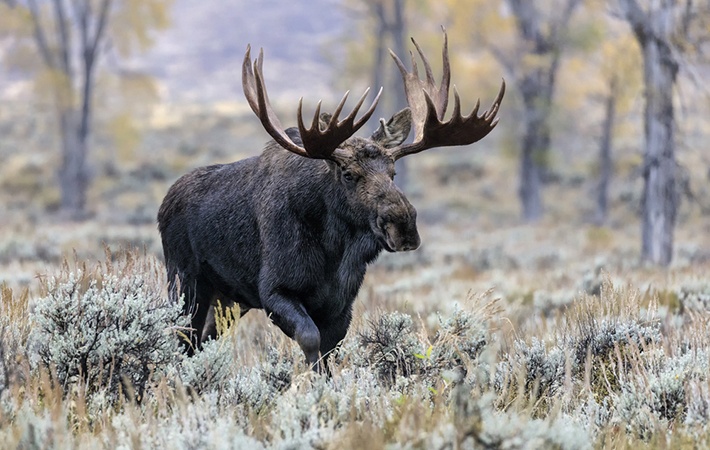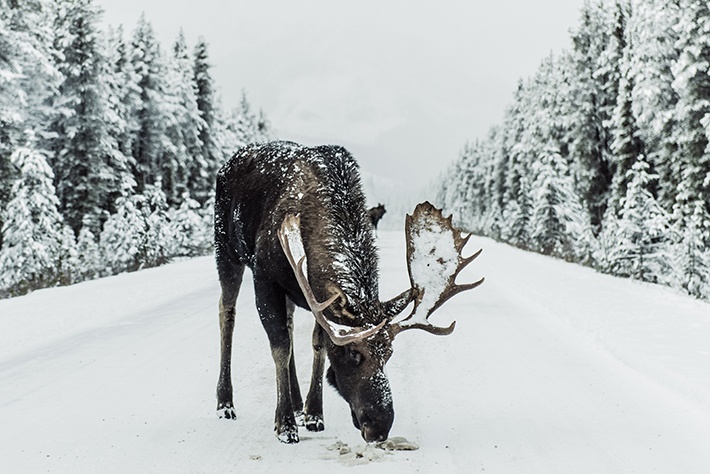Hiking is a truly exhilarating feat that can connect you with all kinds of wonderful creatures in the wild.
From flying squirrels to scary brown bears, you may be able to encounter certain kinds of wild animals if you hike frequently enough in lush mountains or trails.
If you hike in colder regions, one animal you may be able to spot a couple of times is the moose.
It can be quite cool to see a moose minding its own business from afar, but it can also be nerve-wracking if you find yourself head to head with a moose.
So are moose dangerous when encountered in the wild? It actually depends on your current situation.
More...
Try to read this quick guide on what to do when you see a moose in the wild. Remember, being a knowledgeable hiker will not only allow you to maybe keep yourself safe, but other’s lives as well.
A Couple Of Things You Should Know About Moose

Interestingly, moose are nothing like what the cartoons portrayed. If you remember those old TV cartoons, you’d remember how moose were shown as slow and calm animals that seem sleepy all the time.
In reality, moose are very strong animals that can pose lethal threats because of the large antlers in their heads.
The moose is no animal to mess with since it’s a large specie that can get you going to the hospital if you mess with them.
Fortunately, moose are herbivores that have no interest in human meat. They eat plants and mostly tree bark that you’d find sticking out of trees.
As for their demeanor, moose tend to be relatively passive animals. Simply put, if you leave them be, you may get by safely after a moose encounter without a scratch.
Now just because moose are passive animals, that doesn’t mean they don’t have it in them to bring a deadly blow.
Don’t get fooled into thinking that you can easily get away from a moose since moose can often outrun humans. The good thing is that moose don’t really run after humans after a couple of meters.
Moose Encounter Do’s and Don'ts

So what exactly should you do if you find a moose right down the path you are taking? Moose aren’t really that complicated to interact with. Just remember these do’s and don’ts to avoid a moose attack.
Do’s:
- When you find a moose, simply walk around it or away from it. Try to be as far as 50 feet from it.
- When you see moose calves, take a good look around you and try to spot the mother. Mother moose are very protective of their calves, it is best that you stay far away from the calves by walking far and away from them.
- If camping during the winter, it is good practice to keep your food in tight containers that will limit the food’s scent. During the winter season, there’s less food for moose to eat, which can lead them to look for food in new places like an unfamiliar camp. This is also good practice if you want to avoid bears.
Don’ts:
- Never make eye contact with a moose. It may seem like a simple form of communication for humans, but for moose, it can trigger aggression and a potential attack.
- Never feed a moose. Though you may think that you’re doing the moose a favor, it only puts you in a very risky situation. If you’re at arm’s length with a moose and something set off the moose, you may not have a chance at escaping an unexpected attack.
- Don’t come close to moose calves. As I have mentioned above, moose mothers are very protective of their calves. Do not engage with calves or mothers in any way so that the mother won’t see you as a threat.
- If you are hiking with a dog, don’t let your dog go up to the moose. Moose don’t like dogs because they bark at them. A dog barking on a moose will only lead to an aggravated moose that may attack you and your pooch. In this case, an anti-barking device can be useful.
Signs Of A Potential Moose Attack
The most common mistake humans make when it comes to interacting with wild animals is misinterpreting what the animal is trying to say.
Some animals show their aggression with obvious signals just like when a dog pulls back its lips to show its teeth.
Moose on the other hand may show subtler signs of aggression. You may not even notice these signs if you have no idea about them.
If you see a moose doing the following, it would be wise for you to backup and start moving towards the opposite direction if you want to avoid a nasty moose attack:
- The moose’s hairs are up
- The moose’s head is down and the antlers are pointing towards you.
- The moose’s ears are pointed towards its back
- The moose give its lips a lick
- The moose clicks its teeth
- The moose urinates
- The moose moves its head back as if it were a horse
- The moose shows the white parts of its eyes
- The moose walks towards you
If you see any of these signs, the best thing you can do is walk away slowly towards the opposite direction.
As you walk away from the moose, try to avoid sudden movements and loud noises that mays stress out the moose.
Climbing trees is another surefire way to avoid a moose attack especially when the moose is too close to you and running towards you.
Discover More:
What To Do If You’re Attacked By A Moose
In a worse case scenario, a moose may be able to get to you and knock you down to the ground. Unfortunately, being equipped with bear spray will not protect you from a moose attack.
So if this happens, all you have to do is remain silent, curl up into a fetal position, and wait.
I know this doesn’t really help you avoid getting stomped over by a moose repeatedly, but it’s the only thing you can do to make the moose stop attacking you.
Struggling, beating the moose, or trying to fight it in any other way will only make the moose more aggravated and more likely to attack you continuously.
Just curl up into a ball and make sure to protect your head by putting your hands around your head. Being in this position will allow you to protect your body’s vital organs.
Once the moose decides to stop, wait for it to walk away. Don’t try to get up while the moose is still close. Doing so can only trigger the moose to attack you again.
A Quick Recap
Whether you are hiking or trekking outdoors, you will certainly find yourself in the presence of wild animals.
I know it can be feel extraordinary to see wild animals before your eyes, but remember to only look at the animals and not interact with them.
It is because of these interactive attempts that humans get attacked by wild animals. Keep in mind that these animals are untamed and they may not understand what humans are trying to do.
Because of so, they may see you as a threat if you try to interact with them.
When it comes to moose, remember to keep at least 50 feet of space between you and the moose. Avoid making any kind of contact with it and be respectful when you find one in close proximity.
If attacked, protect your vital organs by curling up into a ball and by protecting your head with your hands until the moose walks away from you.
Well there you have it, a guide on what to do if you encounter a moose in the wild. If you want to know more about hiking, trekking, or other outdoor tips, feel free to explore this blog.
You’ll find all sorts of helpful articles that I have written to help outdoor enthusiasts such as myself. Thank you and happy hiking!
